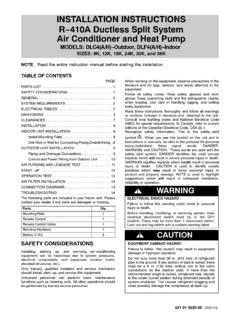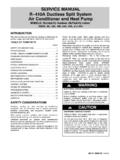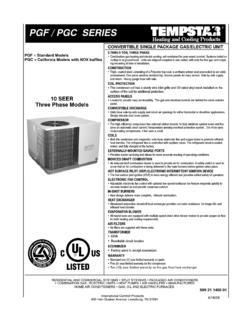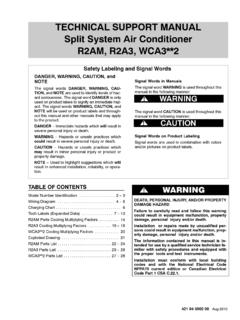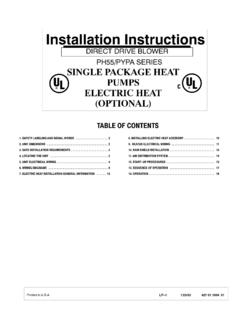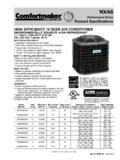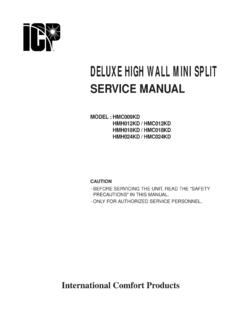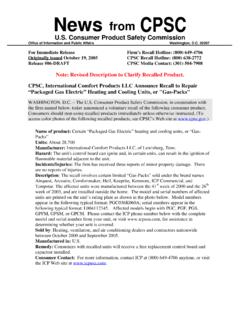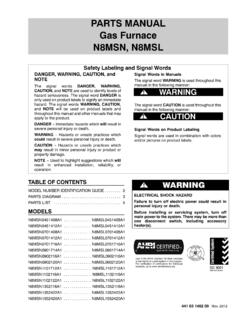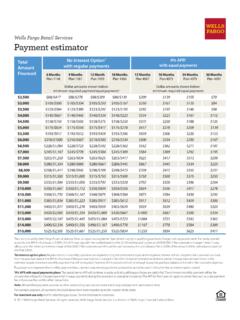Transcription of 80% SINGLE STAGE GAS FURNACES - Documents …
1 80% SINGLE STAGEGAS FURNACESPart Number441 08 2011 00*8 DNL, *8 MPL & *8 MPN B * Denotes brand H, C, TManufactured by:This manual supports SINGLE STAGE B series and later non--condensing gas FURNACES 2001 International Comfort Products Corporation (USA)2/2006*8 DNL-- Dedicated Downflow*8 MPL-- Low NOx Model*8 MPN-- SINGLE STAGE * Denotes Brand (T, C, H or N)Service ManualSingle STAGE Multi Position FurnaceTABLE OF CONTENTS1. INTRODUCTION 2.. 2. UNIT IDENTIFICATION3.. 3. furnace THEORY OF OPERATION3.. 4. ELECTRICAL SUPPLY4.. 5. INTERLOCK SWITCH5.. 6. GAS SUPPLY5.. 7. BURNERS8.. 8. PRESSURE SWITCH8.. 9. HIGH ALTITUDE OPERATION9.. 10. CHECKING TEMPERATURE RISE10.. 11. ROOM THERMOSTATS10.. 12. CONTROL WIRING11.. 13. TWINNING KITS12.. 14. LIMIT SWITCHES12.. 15. PRESSURE SWITCHES13.. 16. LOWER/HIGHER NEGATIVE PRESSURE14.. 17. VENTING SYSTEM14.
2 18. STANDARD VENT TERMINATION15.. 19. COMBUSTION BLOWER16.. 20. SEQUENCE OF OPERATION & DIAGNOSTICS16.. 21. CHECKING FLAME CURRENT19.. 22. CAPACITORS19.. 23. BLOWER ASSEMBLY19.. BLOWER PERFORMANCE DATA (*8 DNL)22.. BLOWER PERFORMANCE DATA (N8 MPL/N or *8 MPL/N)23.. WIRING DIAGRAM (*8 DNL)24.. WIRING DIAGRAM (N8 MPL/N or *8 MPL/N)25.. TECHNICAL SERVICE DATA (*8 DNL)26.. TECHNICAL SERVICE DATA (N8 MPN)27.. TECHNICAL SERVICE DATA (N8 MPL)28.. TECHNICAL SERVICE DATA (*8 MPN) 29.. TECHNICAL SERVICE DATA (*8 MPL) 30.. TROUBLE SHOOTING31.. TROUBLE SHOOTING Chart #1 (continuous fan)33.. TROUBLE SHOOTING Chart #2 (cooling cycle)34.. TROUBLE SHOOTING Chart #3 (heating cycle)35.. INDEX36.. SINGLE STAGE Multi Position FurnaceService Manual441 08 2011 002 INTRODUCTIONThis service manual is designed to be used in conjunctionwith the installation manual and/or technical support manu-al provided with each FURNACES represent the very latest in high efficiencygas furnace technology.
3 Consequently, they incorporatethe use of certain controls that contain highly sophisticatedelectronic components which are not user , it is essential that only competent, qualified, ser-vice personnel attempt to install, service, or maintain Service manual was written to assist the professionalHVAC service technician to quickly and accurately diag-nose and repair any malfunction of this service manual covers the following models; *8 DNL B, *8 MPL B and *8 MPN B models. The overall operation of all ofthese models is essentially the manual, therefore, will deal with all subjects in a gener-al nature ( all text will pertain to all models) unless thatsubject is unique to a particular model or family, in whichcase it will be so will be necessary then for you to accurately identify theunit you are servicing, so you may be certain of a properdiagnosis and repair.
4 (See Unit Identification, Page 3)SAFETY REQUIREMENTSR ecognize safety information. This is the safety alert symbol . When you see this symbol on the furnace and in instructions manuals be alert tothe potential for personal the signal words DANGER, WARNING, or CAUTION. These words are used with the safety alert symbol. DANGER identifies the mostserious hazards, those that will result in severe personal injury or death. WARNING signifies a hazard that could result in personal injury or is used to identify unsafe practices that could result in minor personal injury or product and property damage. NOTE is used to highlightsuggestions that will result in enhanced installation, reliability, or and servicing heating equipment can be hazardous due to gas and electrical components. Only trained and qualified personnel shouldinstall, repair, or service heating service personnel can perform basic maintenance functions such as cleaning and replacing air filters.
5 All other operations must be per-formed by trained service personnel. When working on heating equipment, observe precautions in the literature, on tags, and on labels attached to orshipped with the unit and other safety precautions that may all safety codes. In the United States, follow all safety codes including the current edition National Fuel Gas Code (NFGC) 2002/NFPA No. 54 2002. In Canada, refer to the current edition of the National Standard of Canada Natural Gas and Propane InstallationCode (NSCNGPIC) CSA 05. Wear safety glasses and work gloves. Have fire extinguisher available during start up and adjustment proce-dures and service instructions cover minimum requirements and conform to existing national standards and safety codes. In some instances, these instructionsexceed certain local codes and ordinances, especially those that may not have kept up with changing residential construction practices.
6 We requirethese instructions as a minimum for a safe installation.!cInternational Comfort Products LLCL ewisburg, TN 37091 SINGLE STAGE Multi Position FurnaceService Manual441 08 2011 003 UNIT IDENTIFICATIONThe unit s rating plate contains important information for theservice technician. It also lists the complete ModelManufacturing and Serial complete numbers are required to obtain correct re-placement parts (example, in certain model families a unithaving a MARKETING REVISION of C is likely to beequipped with one or more different NUMBER IDENTIFICATION GUIDE *8M PD0 75B1 2B1 Brand IdentifierEngineering = TempstarDenotes minor changesC = ComfortmakerMarketing DigitH = Heil A = ArcoaireDenotes major changeN = Non Brand Specific (Generic)Cooling AirflowBrand Identifier08 = 800 CFM8 = Non Condensing, 80+% Gas Furnace12 = 1200 CFM9 = Condensing, 90+% Gas Furnace14 = 1400 CFMI nstallation Configuration16 = 1600 CFMUP = UpflowDN = DownflowUH = Upflow/Horizontal20 = 2000 CFMHZ = HorizontalDH = Downflow/HorizontalMP = Multiposition, Upflow/Downflow/HorizontalCabinet WidthMajor Design FeatureB = Wide1 = One ( SINGLE ) PipeN = SINGLE StageF = Wide2 = Two PipeP = PVC VentJ = WideD = 1 or 2 PipeT = Two StageL = WideL = Low NOxV = Variable SpeedInput (Nominal MBTUH) furnace THEORY OF OPERATIONThe high efficiencies and lower profile (compared to pastseries) of this furnace have been obtained using designtechniques not typical of traditional furnace designs.)
7 A briefdescription of these new design techniques and the pur-pose they serve Reducing the height of the furnace while maintainingthe high efficiency of pervious models required main-taining the surface area of the heat exchanger andyet minimizing the overall design required to achieve these results is the SER-PENTINE design, wherein the flue gasses must follow aserpent shaped passage through the heat exchanger Serpentine path is resistive to normal convectiveflow, and requires that a partial vacuum be created at theoutlet of the heat exchanger to maintain the flow of flueproducts through the heat The serpentine heat exchanger design does not lenditself well to the ribbon type, or slotted port type burnerfound in more traditional design FURNACES for the fol-lowing reasons:A. The secondary combustion airflows at right anglesto the burner flame, making it likely to pull theflame off a ribbon or slotted port type The flame height of a ribbon or slotted port typeburner would make it difficult (if not impossible) toprevent impingement of the flame on the heat ex-changer surfaces whole maintaining the low profileheat these reasons, an INSHOT type burner is used in thisseries.
8 The inshot burner (also called a jet burner) fires aflame straight out its end. This burner is designed to fire intoa tube style heat exchanger, making it an ideal applicationin the tube like passages of the serpentine heat To overcome the resistance to convective flow of theheat exchanger requires the use of an Induced DraftCombustion Blower The Combustion Blower Assembly is mounted on theoutlet side of the heat exchanger, This blower createsa partial vacuum (negative pressure) within the heatexchanger drawing the flue products out of the A pressure switch (Air Proving Switch) is used as asafety device that prevents the ignition system fromfiring the furnace until it senses that a proper draft hasbeen established through the STAGE Multi Position FurnaceService Manual441 08 2011 004 SEQUENCE OF OPERATION HEATINGR efer to the ignition control section for the unit you are SUPPLYELECTRICAL SHOCK to turn off power could result in death orpersonal OFF electrical power at fuse box or servicepanel before making any electrical connectionsand ensure a proper ground connection is madebefore connecting line voltage.
9 !WARNINGSUPPLY CIRCUITThe furnace cannot be expected to operate correctly unlessit is properly connected (wired) to an adequately sizedsingle branch voltage wires should conform to temperature limitationof 63 F (35 C) rise and be sized for the unit maximumamps stated on the rating plate. Add the full load amps forpotential field installed accessories that would receive pow-er from the furnace control. Consult NEC, CEC or localcodes for proper wire and circuit VOLTAGES upply voltage to the furnace should be a nominal 115 MUST be between 104 volts and 127 volts. Supply volt-age to the furnace should be checked WITH THE FUR-NACE IN OPERATION. Voltage readings outside the speci-fied range can be expected to cause operating cause MUST be investigated and GROUNDP roper grounding of the electrical supply to the FURNACEIS REQUIRED for safety and operational POLARITY of the line voltage supply to the fur-nace is also required for safety and operational furnace control MUST have proper line voltage polarityto operate GROUNDING AND POLARITYG rounding may be verified as follows:1.
10 Turn the power supply OFF .2. Using an Ohmmeter check for continuity between theNeutral (white) wire and Ground wire (green) of thesupply With the Ohmmeter set on the R x 1 scale, the read-ing should be zero A zero Ohm reading indicates that the neutral isgrounded back to the main An alternate check would be to check for continuityfrom the Neutral to a cold water pipe, (Pipe must bemetal, and must have a continuous, uninterruptedconnection to ground) or to a continuous, uninter-rupted connection to ground or to a driven ground ConnectionsNOTE: 115 VAC/60Hz/ SINGLE phaseOperating voltage range*: 127 VAC max, 104 VAC min.* Permissible limits of voltage at which unit will operate satisfactorily115V. VoltageTerminal BoardRGGYRYWWCF igure 16. Any readings other than zero Ohms would indicatea poor ground, or no may be verified as follows:1.
